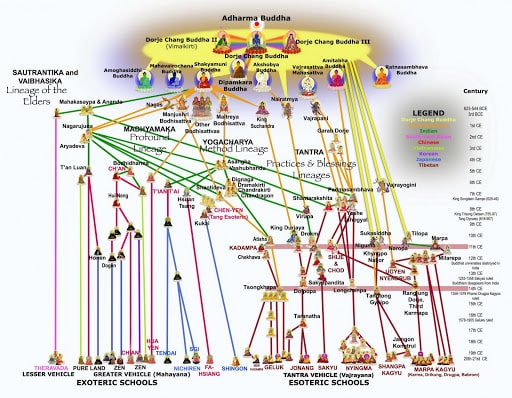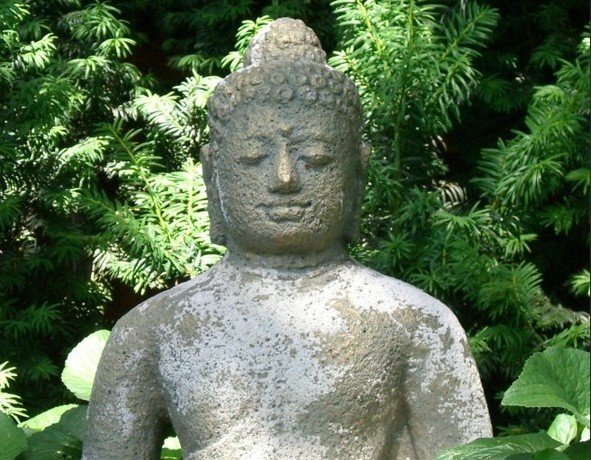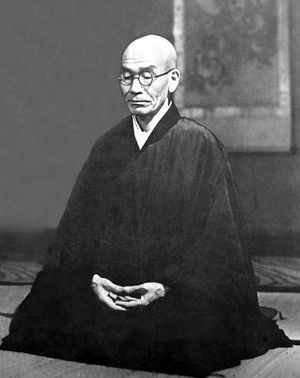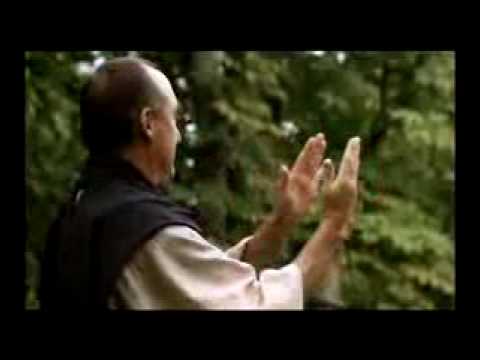Chöd and Dzogchen are the sacred teachings of Buddha who taught 84,000 different categories of teachings classified into nine systems of Sutra and Tantra. Chöd belongs to both Sutra and Tantra. Chöd is a Mahayana practice and from the Sutra point of view, Chöd is an expression of the philosophical view of the Prajnaparamita Sutra or on Transcendental Wisdom. Is a spiritual practice found primarily in the Nyingma and Kagyu schools of Tibetan Buddhism (where it is also known as Mahamudra).
There are two main Chöd traditions within Buddhism, the “Mother” and “Father” lineages. Dampa Sangye is known as the “Father of Chöd” and Machig Labdrön, founder of the Mahamudra Chöd lineages, as the “Mother of Chöd”.
Chöd was mostly practiced outside the Tibetan monastery system by chödpas, who were yogis, yogiṇīs and ngagpas rather than bhikhus (monks and nuns).
The Tibetan word “chöd” means “to cut off” or “to slay.” The traditional practice of Chöd cuts off self-cherishing and grasping at a truly existent “I.” It creates the conditions under which one can develop the mind of conventional bodhicitta, which holds others as more dear than oneself, and the mind of ultimate bodhicitta, which sees reality as it truly is. Attributed to the great Tibetan yogini Machig Labdron, and the only practice that made its way back to India from Tibet, it is an extremely effective and quick tantric method for attaining realizations of the path to enlightenment.
Chöd (“cutting through”) is a meditative practice in which the practitioner imagines offering his or her body in sacrifice through elaborate contemplative visualization. Although a meditative practice, Chöd is often practiced in terrifying places like cemeteries or charnel grounds. The feelings of fear that result are used by the Chöd practitioner to “cut through” his or her own ego. Chöd contains elements of early shamanism, of Sutric and Tantric teachings also found in Indo-Tibetan Buddhism, and of the Tibetan highest school of Dzogchen.
Chöd means to sever or cut the root of dualistic mind which is ignorance, and its offshoots, the five conflicting emotions. Specifically, the two extremes of expectation and disappointment must be eliminated: the expectation of attaining enlightenment or the fear of not attaining it; the hope for something positive and the fear of something negative.
There are two approaches to cut through the grasping to identity. One is based on studying the vast and extensive scriptures and then applying what is learned in order to achieve realization. The other way is to use the power of faith and devotion combined with the Lama’s blessings so that realization can be transferred to and realized by the mind of the disciple. These are the ways of attaining the view of Chöd according to Sutra.
Practitioners of Chöd are traditionally nomadic, travelling continually from place to place with a minimum of possessions, as mendicants, often carrying nothing more than the ritual instruments of a damaru, or two-sided drum, a bell, a thighbone trumpet and living in a small tent set up using a ritual trident (katvanga) as its tent pole, and four ritual daggers (purba) as its tent pegs. The practitioners of the Chöd ritual, the Chödpas, use a kangling or human thighbone trumpet, and a Chöd drum, a hand drum similar to (but larger than) the ḍamaru drum commonly used in the traditional Tibetan ritual. The appearance of chöpas was often dramatic, from wandering naked dressed only in shells, feathers, and ornaments of bone and conch to wearing the full garb of the traditional Tibetan ngakpa. But just as often, the garb of the chödpa was the unassuming garb of the Tibetan chuba worn by lay men and woman all over Tibet.
The Chöd practice is principally undertaken in lonely and desolate places, such as caves and mountain peaks, but particularly in graveyards and charnel grounds at night, when the terrifying energy of such places serves to intensify the sensation of the practitioner who, seated alone in the dark, summons all those to whom he owes a karmic debt to come and receive payment in the form of the offering of his body. This practice is popular among beggars or retreatants who have given up everything and live isolated in the mountains. They have nothing concrete to offer, no possession at all, except for their body. So they invite the lamas, meditational deities, dakinis, dharma protectors and lesser gods and spirits to come and partake of their body.
The purpose of the practice is to engender a sense of victory and fearlessness. By summoning up what is most dreaded and openly offering what we usually most want to protect, the Chöd works to cut out of the double bind of the ego and attachment to the body. The name Chöd means ‘to cut’, but it is the attachment, not the body itself, that is the problem to be cut through. Despite this terrifying practice, the human body is regarded as a precious vehicle for the attainment of realization.
Chöd practice can be viewed in a threefold manner: external, inner and secret. The external practice of Chöd is to go to a qualified Lama and receive the complete instructions on how to do every aspect of the practice. The internal practice is to simply relax in a natural state and remain in the view while all mental phenomena, such as displays and visions, are occurring.
The internal conduct of Chöd practice is the development of the compassionate aspect of bodhicitta as a result of realizing identitylessness. At this time, compassion is constantly present and wells up as one sees the sufferings and predicaments of all sentient beings who have not realized identitylessness. This is known as great compassion. It is also the essence of Dharmakaya or nature “as it is.”
The secret conduct of Chöd practice is called “tulshuk” or uncontrived conduct. This means fearlessness and abstinence from expectation and disappointment, even the hope for enlightenment and realization of identitylessness; also, the fear of falling into lower samsaric realms. When “tulshuk” is perfected, the practitioner is known as a thoroughly pure practitioner of secret Chöd.
Photo credit: treasuryoflives




